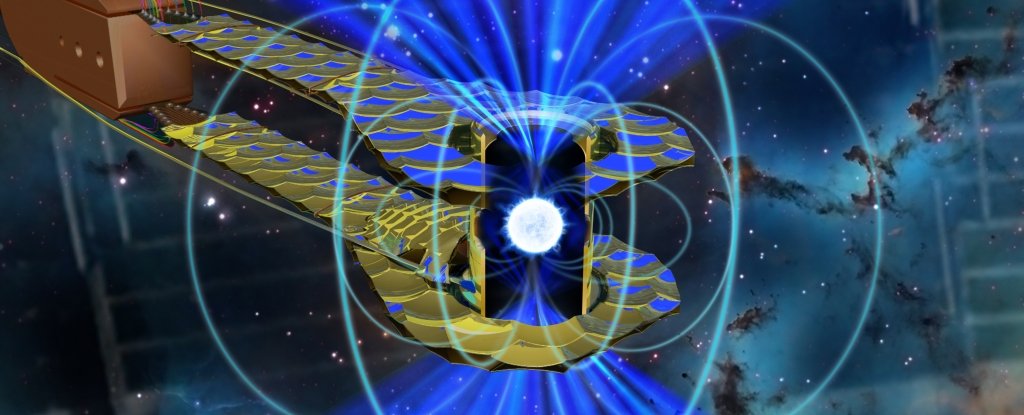Products You May Like
For the first time, pressure over 100 times that found in Earth’s core has been generated in a lab, setting a new record.
Using the highest-energy laser system in the world, physicists briefly subjected solid hydrocarbon samples to pressures up to 450 megabars, meaning 450 million times Earth’s atmospheric pressure at sea level.
That’s equivalent to the pressures found in the carbon-dominated envelopes of a rare type of white dwarf star – some of the densest objects in the known Universe. It could help us to better understand the effect those pressures have on changes in the stars’ brightness.
Most of the stars in the Universe will end their lives as a white dwarf, including our Sun. As they reach the end of their main-sequence, hydrogen-fusing days, they’ll puff out into red giants, eventually ejecting most of their material out into space as the core collapses into a white dwarf – a ‘dead’ star no longer able to support fusion.
White dwarfs are dense. They can be up to around 1.5 times the mass of the Sun, packed into a sphere the size of Earth. Only something called electron degeneracy pressure keeps the star from collapsing under its own gravity.
At around 100 megabars of pressure, electrons are stripped from their atomic nuclei – and, because identical electrons can’t occupy the same space, these electrons supply the outward pressure that keeps the star from collapsing.
This pressure doesn’t just influence how compressible the material is, it also decreases the opacity of the plasma ionised by the loss of electrons. And the links between these properties are described by the material’s equations of state, which also can be used to calculate such properties as the temperature profile and rate of cooling.
There are, however, some disagreements in equation of state (EOS) models for extreme pressures; for white dwarf stars, the EOS models along what is known as the shock Hugoniot – the curve that plots the increase in pressure and density under compression – can vary by 10 percent.
This can be a problem when trying to understand the fundamental properties of the Universe, because white dwarf stars should be quite predictable. Although they shine, the light is only from residual heat, not fusion, and their cooling rate can therefore be used as a sort of clock to confirm the age of the Universe, for instance, and the ages of the stars around them.
So this is what the research team is trying to resolve, using the laser system at the Lawrence Livermore National Laboratory’s National Ignition Facility (NIF).
“White dwarf stars provide important tests of stellar physics models, but EOS models at these extreme conditions are largely untested,” said physicist Annie Kritcher of the Lawrence Livermore National Laboratory.
“NIF can duplicate conditions ranging from the cores of planets and brown dwarfs to those in the centre of the Sun. We’re also able in NIF experiments to deduce the opacity along the shock Hugoniot. This is a necessary component in studies of stellar structure and evolution.”
The experimental set-up consisted of a small, solid, one-millimetre hydrocarbon (plastic) bead inside a hollow gold cylinder about the size of a pencil eraser called a hohlraum. This was then irradiated with 1.1 million joules of ultraviolet light delivered by the lasers, which created a uniform X-ray bath heating the plastic sphere to nearly 3.5 million Kelvin.
The outer layer of the bead was destroyed through ablation, which created a spherical ablation shockwave travelling up to 220 kilometres per second that converged spherically, resulting in increasing pressure as it propagated through the bead.
By the way, all this happened extraordinarily quickly – the shockwave took just 9 nanoseconds to traverse the entire sample – but, using X-ray radiography, the research team was able to record the shock Hugoniot, measuring pressures of 100 megabars on the outside of the bead to 450 megabars by the time it reached the middle.
The pressure inside Earth’s core is 3.6 megabars. And, previously, the highest pressure achieved in this kind of controlled experiment was 60 megabars.
The pressure generated in their experiment, the team said, is consistent with the carbon envelope – the convection region surrounding the core – seen in what are known as “hot DQ” white dwarfs. These are relatively rare; unlike ordinary white dwarfs, whose atmospheres are composed primarily of hydrogen and helium, hot DQs have primarily carbon atmospheres, and they’re unusually hot and bright.
Some of them also pulsate as they spin, resulting in brightness variations. To understand these pulsations and model them, we need an accurate understanding of how the matter in the star behaves under pressure.
In addition to X-ray radiography, the physicists used X-ray Thomson scattering to measure the electron temperature and degree of ionisation in the sample. It, too, turned up hot DQ.
“We measured a reduction in opacity at high pressures, which is associated with a significant ionisation of the carbon inner shell,” Kritcher said.
“This pressure range along the Hugoniot corresponds to the conditions in the carbon envelope of white dwarf stars. Our data agree with equation-of-state models that include the detailed electronic shell structure.”
What this means is that the ionisation ultimately makes the material more compressible than models that don’t have electronic shells. This places new constraints on the compressibility and opacity of the carbon envelope in hot DQs, which in turn can contribute to a better understanding of their properties and evolution. All this, from a lab experiment on our own planet.
The research has been published in Nature.
